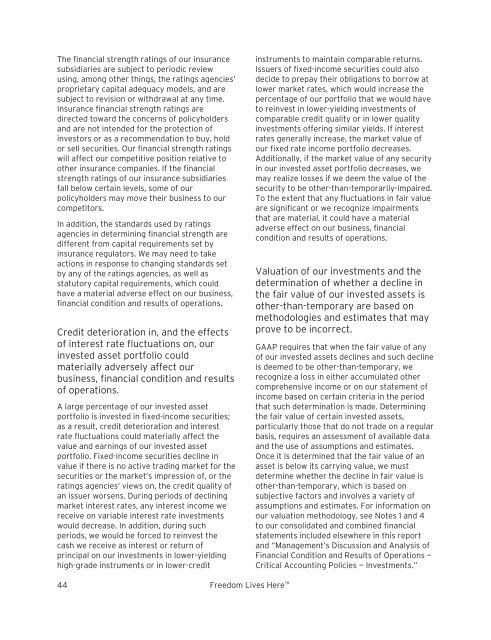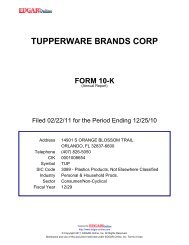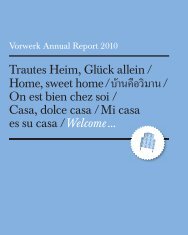The financial strength ratings of our insurancesubsidiaries are subject to periodic reviewusing, among other things, the ratings agencies’proprietary capital adequacy models, and aresubject to revision or withdrawal at any time.Insurance financial strength ratings aredirected toward the concerns of policyholdersand are not intended for the protection ofinvestors or as a recommendation to buy, holdor sell securities. Our financial strength ratingswill affect our competitive position relative toother insurance companies. If the financialstrength ratings of our insurance subsidiariesfall below certain levels, some of ourpolicyholders may move their business to ourcompetitors.In addition, the standards used by ratingsagencies in determining financial strength aredifferent from capital requirements set byinsurance regulators. We may need to takeactions in response to changing standards setby any of the ratings agencies, as well asstatutory capital requirements, which couldhave a material adverse effect on our business,financial condition and results of operations.Credit deterioration in, and the effectsof interest rate fluctuations on, ourinvested asset portfolio couldmaterially adversely affect ourbusiness, financial condition and resultsof operations.A large percentage of our invested assetportfolio is invested in fixed-income securities;as a result, credit deterioration and interestrate fluctuations could materially affect thevalue and earnings of our invested assetportfolio. Fixed-income securities decline invalue if there is no active trading market for thesecurities or the market’s impression of, or theratings agencies’ views on, the credit quality ofan issuer worsens. During periods of decliningmarket interest rates, any interest income wereceive on variable interest rate investmentswould decrease. In addition, during suchperiods, we would be forced to reinvest thecash we receive as interest or return ofprincipal on our investments in lower-yieldinghigh-grade instruments or in lower-creditinstruments to maintain comparable returns.Issuers of fixed-income securities could alsodecide to prepay their obligations to borrow atlower market rates, which would increase thepercentage of our portfolio that we would haveto reinvest in lower-yielding investments ofcomparable credit quality or in lower qualityinvestments offering similar yields. If interestrates generally increase, the market value ofour fixed rate income portfolio decreases.Additionally, if the market value of any securityin our invested asset portfolio decreases, wemay realize losses if we deem the value of thesecurity to be other-than-temporarily-impaired.To the extent that any fluctuations in fair valueare significant or we recognize impairmentsthat are material, it could have a materialadverse effect on our business, financialcondition and results of operations.Valuation of our investments and thedetermination of whether a decline inthe fair value of our invested assets isother-than-temporary are based onmethodologies and estimates that mayprove to be incorrect.GAAP requires that when the fair value of anyof our invested assets declines and such declineis deemed to be other-than-temporary, werecognize a loss in either accumulated othercomprehensive income or on our statement ofincome based on certain criteria in the periodthat such determination is made. Determiningthe fair value of certain invested assets,particularly those that do not trade on a regularbasis, requires an assessment of available dataand the use of assumptions and estimates.Once it is determined that the fair value of anasset is below its carrying value, we mustdetermine whether the decline in fair value isother-than-temporary, which is based onsubjective factors and involves a variety ofassumptions and estimates. For information onour valuation methodology, see Notes 1 and 4to our consolidated and combined financialstatements included elsewhere in this reportand “Management’s Discussion and Analysis ofFinancial Condition and Results of Operations —Critical Accounting Policies — Investments.”44 Freedom Lives Here
There are certain risks and uncertaintiesassociated with determining whether declinesin market value are other-than-temporary.These include significant changes in generaleconomic conditions and business markets,trends in certain industry segments, interestrate fluctuations, rating agency actions,changes in significant accounting estimates andassumptions and legislative actions. In the caseof mortgage- and asset-backed securities, thereis added uncertainty as to the performance ofthe underlying collateral assets. To the extentthat we are incorrect in our determination ofthe fair value of our investment securities orour determination that a decline in their valueis other-than-temporary, we may realize lossesthat never actually materialize or may fail torecognize losses within the appropriatereporting period.The failure by any of our reinsurers toperform its obligations to us could havea material adverse effect on ourbusiness, financial condition and resultsof operations.We extensively use reinsurance in the UnitedStates to diversify our risk and to manage ourloss exposure to mortality risk. Reinsurancedoes not relieve us of our direct liability to ourpolicyholders, even when the reinsurer is liableto us. We, as the insurer, are required to paythe full amount of death benefits even incircumstances where we are entitled to receivepayments from the reinsurer. Due to factorssuch as insolvency, adverse underwritingresults or inadequate investment returns, ourreinsurers may not be able to pay thereinsurance recoverables they owe to us on atimely basis or at all. Reinsurers might refuse orfail to pay losses that we cede to them or mightdelay payment. Since death benefit claims maybe paid long after a policy is issued, we bearcredit risk with respect to our reinsurers. Thecreditworthiness of our reinsurers may changebefore we can recover amounts to which we areentitled.No assurance is given that our reinsurers willpay the reinsurance recoverables owed to usnow or in the future or that they will pay theserecoverables on a timely basis. Any such failureto pay by our reinsurers could have a materialadverse effect on our business, financialcondition and results of operations.The failure by Citi to perform itsobligations to us under our coinsuranceagreements could have a materialadverse effect on our business,financial condition and results ofoperations.Immediately prior to the Offering, we enteredinto four coinsurance agreements with threereinsurer affiliates of Citi pursuant to which weceded between 80% and 90% of the risks andrewards of our term life insurance policies thatwere in force at year-end 2009. Under thisarrangement, our current third-partyreinsurance agreements remain in place. Thelargest of these transactions involved twocoinsurance agreements between <strong>Primerica</strong>Life and Prime Re. Prime Re was formed solelyfor the purpose of entering into thesereinsurance transactions, has no operatinghistory and does not possess a financialstrength rating from any rating agency. Theother transactions were between (1) <strong>Primerica</strong>Life Canada and Financial ReassuranceCompany <strong>2010</strong> Ltd., a Bermuda reinsurerformed to operate solely for the purpose ofreinsuring Citi-related risks and is a whollyowned subsidiary of Citi, and (2) NBLIC andAmerican Health and Life Insurance Company(“AHL”), a wholly owned insurance subsidiaryof Citi that has a financial strength rating of “A”by A.M. Best. Each of the three reinsurersentered into trust agreements with ourrespective insurance subsidiaries and a trusteepursuant to which the reinsurer placed assets(primarily treasury and fixed-income securities)in trust for such subsidiary’s benefit to securethe reinsurer’s obligations to such subsidiary.Each such coinsurance agreement requireseach reinsurer to maintain assets in trustsufficient to give the subsidiary full credit forregulatory purposes for the insurance, whichamount will not be less than the amount of thereserves for the reinsured liabilities. In addition,in the case of the reinsurance transactionsbetween Prime Re and <strong>Primerica</strong> Life, Citi has<strong>Primerica</strong> <strong>2010</strong> <strong>Annual</strong> <strong>Report</strong> 45
- Page 1 and 2:
Freedom Lives Here 2010 Annual Repo
- Page 3 and 4:
A Main Street Company for Main Stre
- Page 5 and 6:
North America’s vastmiddle-income
- Page 7 and 8:
More than 50 percent of U.S. househ
- Page 9 and 10:
We are PrimericaPrimerica is a Main
- Page 11 and 12:
Primerica helps familiescreate a fi
- Page 13 and 14: René Turner wasalways told growing
- Page 15 and 16: We teach people how money works.We
- Page 19 and 20: UNITED STATESSECURITIES AND EXCHANG
- Page 21 and 22: CAUTIONARY STATEMENT CONCERNING FOR
- Page 23 and 24: PART IITEM 1.BUSINESSOverviewPrimer
- Page 25 and 26: them reduce and ultimately pay off
- Page 27 and 28: With the support of our home office
- Page 29 and 30: ecognized with the sales representa
- Page 31 and 32: force. We also profile successful s
- Page 33 and 34: • bonuses and other compensation,
- Page 35 and 36: originators (and in some states as
- Page 37 and 38: We organize and manage our business
- Page 39 and 40: premiums that are less per person p
- Page 41 and 42: insurance policies that we underwri
- Page 43 and 44: assistance, has developed a series
- Page 45 and 46: SEC, FINRA and with respect to 529
- Page 47 and 48: they sell insurance policies. Our C
- Page 49 and 50: preceding 12 months, exceed this st
- Page 51 and 52: interest rate risk and business ris
- Page 53 and 54: operational support to its subsidia
- Page 55 and 56: Privacy of Consumer Information. U.
- Page 57 and 58: media. This negative commentary can
- Page 59 and 60: with such laws and regulations, inc
- Page 61 and 62: and disrupt the economy. Although w
- Page 63: Our financial strength and credit r
- Page 67 and 68: 26). The update revises the definit
- Page 69 and 70: conduct standards prescribed by FIN
- Page 71 and 72: licensing requirements have caused,
- Page 73 and 74: Terrorist Financing Act and its acc
- Page 75 and 76: educing dividends or other amounts
- Page 77 and 78: housed at our Duluth and Roswell, G
- Page 79 and 80: • for dates as of or periods endi
- Page 81 and 82: to and subject to the limitations o
- Page 83 and 84: Field Audit Department from 1993 to
- Page 85 and 86: Securities Authorized for Issuanceu
- Page 87 and 88: ITEM 6.SELECTED FINANCIAL DATA.The
- Page 89 and 90: pursuant to which we issued to a wh
- Page 91 and 92: ecruiting boost we experienced in t
- Page 93 and 94: • Mortality. We use historical ex
- Page 95 and 96: • sales of a higher proportion of
- Page 97 and 98: on quality rating, average life and
- Page 99 and 100: Deferred Policy Acquisition Costs(D
- Page 101 and 102: life insurance processing responsib
- Page 103 and 104: einsurance agreements impacted the
- Page 105 and 106: Notes to the Pro Forma Statement of
- Page 107 and 108: Term Life Insurance Segment ProForm
- Page 109 and 110: Investments and Savings ProductsSeg
- Page 111 and 112: We believe that the pro forma resul
- Page 113 and 114: ecognized in 2008. Excluding the ef
- Page 115 and 116:
amortize the higher DAC balance res
- Page 117 and 118:
Corporate and Other DistributedProd
- Page 119 and 120:
The composition of our invested ass
- Page 121 and 122:
LIQUIDITY AND CAPITALRESOURCESDivid
- Page 123 and 124:
surplus notes, hybrid securities or
- Page 125 and 126:
ITEM 7A. QUANTITATIVE ANDQUALITATIV
- Page 127 and 128:
AssetsPRIMERICA, INC. AND SUBSIDIAR
- Page 129 and 130:
PRIMERICA, INC. AND SUBSIDIARIESCon
- Page 131 and 132:
PRIMERICA, INC. AND SUBSIDIARIESCon
- Page 133 and 134:
which we are able to reinvest at ou
- Page 135 and 136:
with reinsured policies. Ceded poli
- Page 137 and 138:
indemnify and hold the Company harm
- Page 139 and 140:
New Accounting PrinciplesScope Exce
- Page 141 and 142:
immediately contributed back to us
- Page 143 and 144:
The Investment and Savings Products
- Page 145 and 146:
(4) InvestmentsOn March 31, 2010, w
- Page 147 and 148:
The following tables summarize, for
- Page 149 and 150:
The net effect on stockholders’ e
- Page 151 and 152:
The amortized cost and fair value o
- Page 153 and 154:
The roll-forward of credit-related
- Page 155 and 156:
having similar tenors (e.g., sector
- Page 157 and 158:
(5) Financial InstrumentsThe carryi
- Page 159 and 160:
Due from reinsurers includes ceded
- Page 161 and 162:
(8) Intangible Assets and GoodwillT
- Page 163 and 164:
(11) Note PayableIn April 2010, we
- Page 165 and 166:
Income tax expense (benefit) attrib
- Page 167 and 168:
above, plus an additional 7,098 com
- Page 169 and 170:
Non-Employee Share-BasedTransaction
- Page 171 and 172:
We had arrangements with Citi in re
- Page 173 and 174:
Contingent LiabilitiesThe Company i
- Page 175 and 176:
ITEM 9. CHANGES IN ANDDISAGREEMENTS
- Page 177 and 178:
Members of Our Board of DirectorsTh
- Page 179 and 180:
finance, and risk and asset managem
- Page 181 and 182:
PART IVITEM 15. EXHIBITS AND FINANC
- Page 183 and 184:
10.4 Long-Term Services Agreement d
- Page 185 and 186:
10.29 Employment Agreement, dated a
- Page 187 and 188:
Schedule ISummary of Investments
- Page 189 and 190:
Schedule IICondensed Financial Info
- Page 191 and 192:
Schedule IICondensed Financial Info
- Page 193 and 194:
101% of the outstanding principal a
- Page 195 and 196:
GrossamountSchedule IVReinsurancePR
- Page 197 and 198:
Annual MeetingThe annual meeting of









